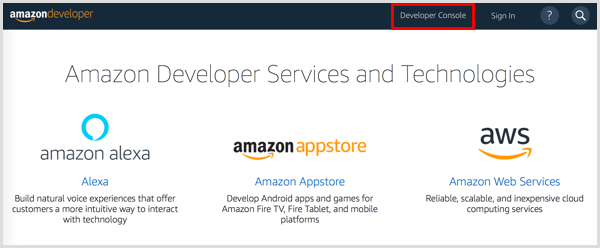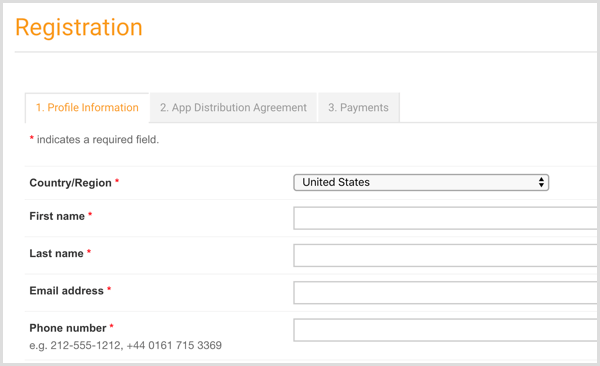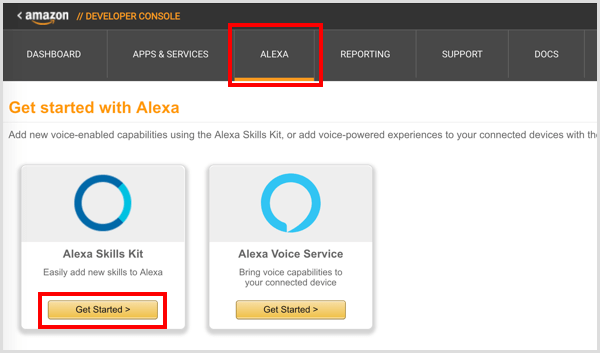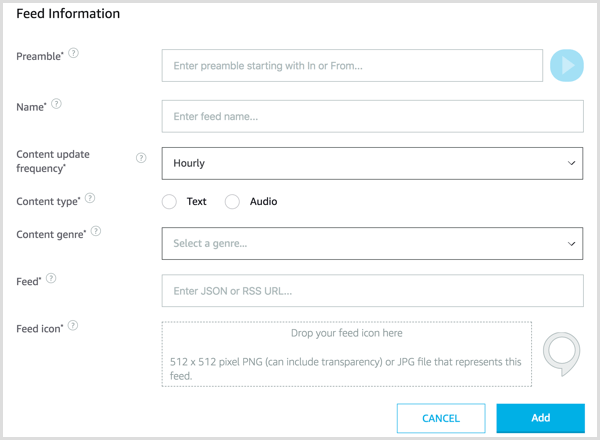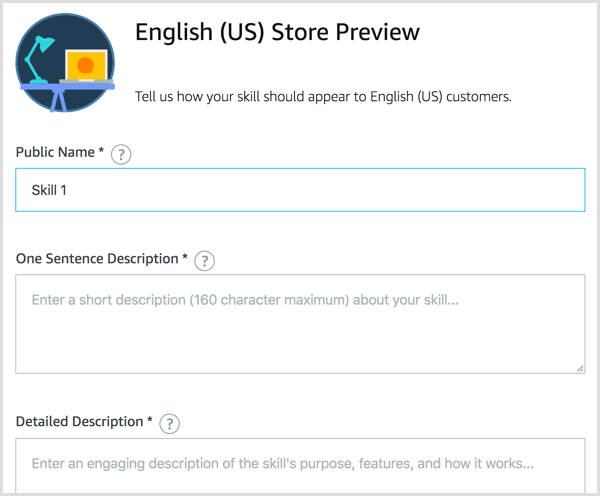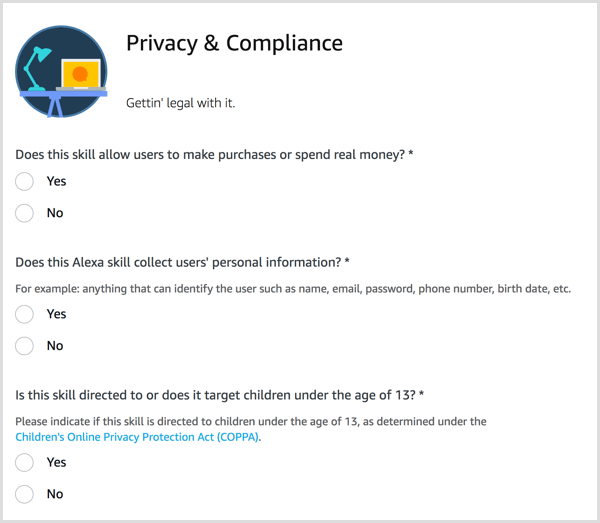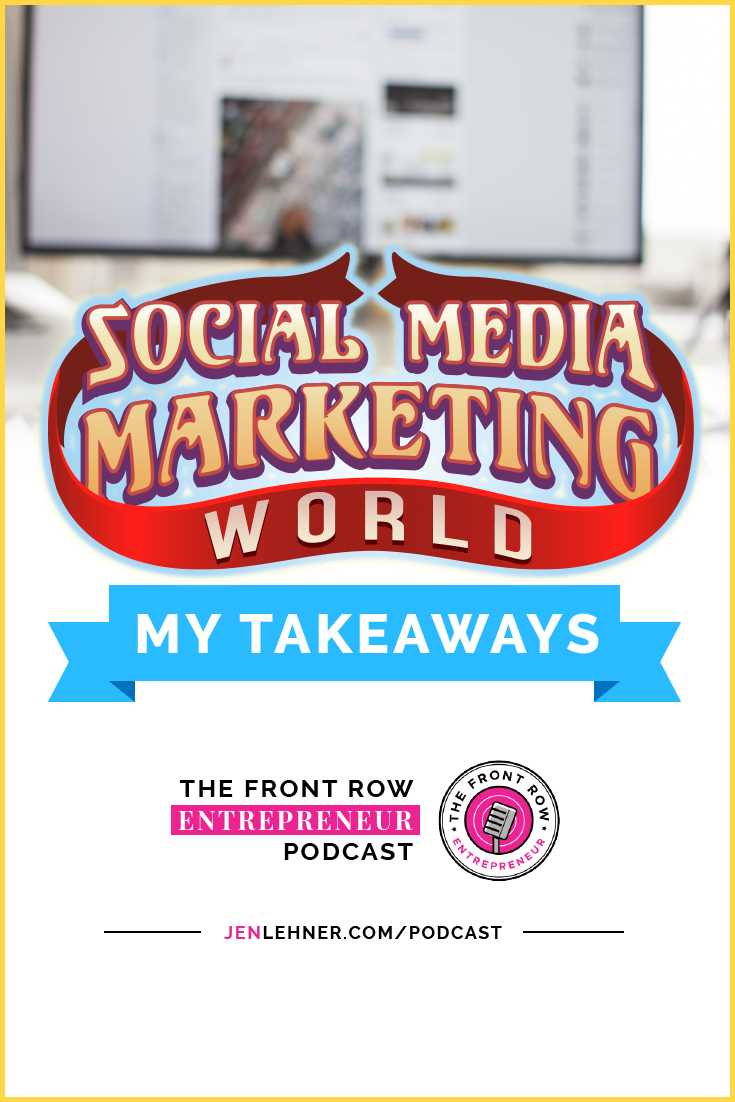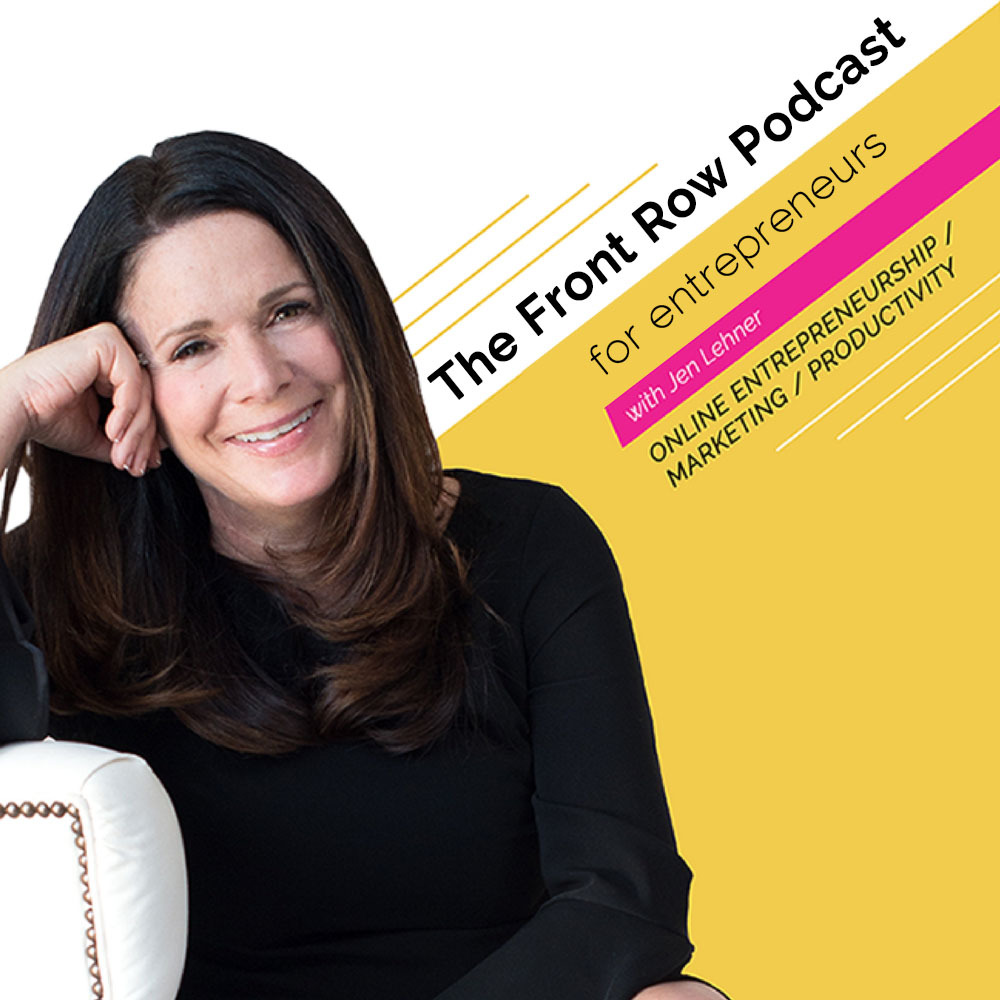!
TRANSCRIPT OF PODCAST EPISODE
I was so blown away by the results I was getting for my business and with my audience growth. What we are starting to understand about the way people are consuming voice is that they are making these briefings part of their day. Most people are able to commit to content that is 10 mins or less because they are listening during those transitional moments....drinking their coffee on their way out the door, fixing the kids lunches, getting dresses in the morning. No other piece of content could reach this audience.
What is a flash briefing?
A flash briefing is an audio clip, 10 minutes or less, that you upload to Amazon. People subscribe to your flash briefing by enabling it in their Alexa skills app or on amazon.com.After that, they hear your briefing when they give the command, "Alexa, play my flash briefing."
Setting up a flash briefing only takes about 20 to 30 minutes if you use a platform that allows you to bypass having to code. The platform I recommend is called Soundup. and if you go to soundupnow.com and use the code frontrow, you’ll get a nice discount, but it’s very affordable even without the discount.
You don’t have to have an Alexa device in order to create a flash briefing. All you need is a computer, and a microphone. After you set up your briefing, you never have to do it again. One important thing to remember here is to use all 30 keywords that Amazon allows you to use when you set up your briefing. Your briefing is searchable from Amazon.com, which in and of itself is mind-blowing, so keep this in mind when you name your briefing and with those keywords.
If you aren’t sure what keywords to use, you can use Google Keyword Planner for an approximation. Here’s a ninja tip for you: find top briefings in your niche and use the title of their briefing as one of your keywords. I recommend rotating your keywords monthly until you find the ones that are working well for you. Amazon does give you an analytics dashboard so you can always see how many listeners you have on any given day week or month.
I’ve had my briefing, the Front Row Entrepreneur Flash Briefing for about a year now and based on what I’ve seen I do believe that voice is here to stay and that now is the time to jump in.
As of April 2018, Amazon reported that there are 50000 Alexa skills and while that’s a lot, if you think about it, it’s not really a lot. What if i said there were 50k websites in the world? or 50k podcasts? To me, this sounds like a number that validates briefings as a viable means of content distribution and as a marketing channel, but tells me that this is probably the perfect time to jump in because I have a chance of getting found before that 50K number turns into 50 million.
60% of Amazon Prime members already own a smart speaker and there are more than 100 million Amazon prime members. That’s 60 million people right there and 30% of non prime members own a smart speaker. I don’t know what that number is, but you can be sure it’s a lot.
The holidays are just around the corner, and I guess the number of people who own smart speakers is going to increase exponentially. I'm willing to bet that these devices will become as ubiquitous as televisions in every american household and soon enough, across the globe.
BMW just announced that they are incorporating Alexa into their dashboard. You may already buy products through your Amazon Echo. I know I do. I’ll find myself in the middle of a recipe, realize I need organic Tahini or preserved lemons or some other inconvenient item, and will just shout it out to Alexa and two days later it’s at my doorstep.
I’m no Nostradamus but let me just put this out there. If you currently have an Amazon affiliate account, meaning, you can share links to products and get a commission, I’m sure it’s only a matter of time that we will be able to do the same thing through our flash briefings. And I’m sure that won’t be the end out how we will be able to directly monetize our briefings. They bottom line is that you need to be paying attention to this trend. The possibilities for marketers and businesses are mind-blowing.
We are going to focus on using our flash briefings to build an audience and covert our audience into customers. The number one thing I’ve learned with flash briefings is that like with content creation, we must be consistent. When I first started, I was publishing my briefing once a week. Then one day, a listener left me a review and said that the content was good, but that she had to listen to the same thing every day until I published the new one the following week. This was a real eye opener.
When you set up your briefing, you either tell Amazon you will publish daily or weekly. If you say you will publish weekly, then your listeners will hear the same thing for a week. After a week, if you don't publish anything new, Alexa will tell your listeners, "There is no new content" or something to that effect.
What I recommend is setting up your briefing for weekly publishing, but publish every day. This way, if you miss a day, your listeners won't get an error message. I know you are thinking, “No way, I am not going to record a flash briefing every day.” Don't worry, you don't have to. Like with podcasts, you can batch record your content and schedule them in advance and because flash briefings are so short, you can knock off probably a months worth of content in no time at all.
I do actually record every day, or at least Monday to Friday, but that's because my flash briefing is news. It's all about the latest news in online marketing and online business. I do take the weekends off, however, and based on the limited amount of research that is out there right now, it appears that listeners aren't as tuned in on the weekends.
But while we're on the subject, I have to say that incorporating this into my morning routine has been by itself one of the best decisions I've every made. Outside of the fantastic ROI of my time and energy, this has become a very important cornerstone of my day.
I get up at 5:08 ever morning and get to my 6am yoga class about 20 minutes early. I write my morning pages, and the minute I get home, I walk to my office in the back of my house, and record my flash briefing. Before my day has even begun I have created something. If nothing else goes right all day long, I know I've created a piece of content that has helped someone, somewhere because I'm reporting the news. I've also learned new things in a way I wasn't learning before because I'm reading an article about the latest changes in Twitter or Facebook Ads or whatever. Then I have to condense it and interpret it for my audience. I have to truly understand what I am talking about. My own knowledge base has increased so much by doing this that by itself, even before all the new email subscribers and listeners and members of my Facebook group, and new customers, I would say it's been worth it.
If you don't want to do daily, Soundup allows you to upload all of your batched content. You put the publishing date and it that's it. The actual process of creating the briefing couldn't be simpler. it's rally the easiest content I create all day long. I use Zencastr but you can really use anything that allows you to record audio. Like GarageBand or Audacity, which is free then upload the briefing to Soundup and that's absolutely it.
Having a short musical intro and outro is great for brand recognition and it adds a certain level of legitimacy and professionalism. Let your listeners know how to contact you and make it interactive. I often ask people to tweet at me or tag me on Instagram. It's a thrill to see it in action. I always drive people to my Facebook group and because one of the questions I ask members when they fill out the application form is how did you hear about this group, I can see all the people who are coming straight from the briefing. Even more exciting are the number of people who are joining my paid VIP community because of the briefing.
Since this is a self contained thing, you don't necessarily have to tie this to your existing brand. In fact, you don't even have to tie this into your existing business. Maybe you are a huge fan of growing orchids. You have so many tips about growing orchids you could go on forever. Start a flash briefing called Daily Orchid Tips then spend a Saturday afternoon creating 30 one minute tips about growing orchids. Maybe in each recording you mention a link to your favorite orchid growing medium, is that even a thing, I don't know, your favorite orchid dirt. You send people to a simple landing page where you have the show notes and maybe an affiliate link to that dirt.
Let's say you are a realtor, and you do want to tie your briefing in with your existing business. I would create a briefing that focuses on your town. So if you live in Minneapolis, maybe it's just called the Minneapolis minute. You can highlight events happening each day, talk about civic news, favorite restaurants. Maybe at the end of each briefing you mention that this Minneapolis Minute is brought to you by Sarah Johnson, Minneapolis's favorite realtor and you also have a show notes page. When people come to that page, they see links to the resources you mentioned, but also a picture of you with your contact info. But you will be using the briefing to build authority as Minneapolis expert, “the go to person” for information about Minneapolis.
If you are a financial advisor, or a money person, stock tips or investing tips would be fantastic. Coaches can create tips based on whatever your SME is. Is your audience made up of parents of young kids? How about a story telling app? I really can't think of any business or industry that can't create a flash briefing. It may not be that you are going after an audience of thousands. Maybe you create a flash briefing that is for internal use only for a select group.
If you are a marketer who works directly with clients, can you imagine the response when you head into your pitch meeting to discuss all the things you can offer them and then plug in your echo and say, Alexa, play my flash briefing and they hear the sample flash briefing you set up that features their company. They will fall out of their chair and start throwing money at you then you can set up their flash briefing in your Soundup account and then you can easily systemize the process by either getting the client to email you a batch of recordings each month or you can record with them on location. The point is, the margins on this are great for you, with your only relay overhead being your time and even that can be minimized. Your clients will be delighted, too. Again, now is the time for this because your competitors haven't thought of this yet.
Now you have a flash briefing, now what? How do you get listeners?
Unfortunately Amazon isn't going to market your briefing for you. Here are some things you can do:
Create a bitly link to your skill in the amazon Alexa skill store. The link that you are given by default is long and cumberson. Creating a short link is not just easier to manage, but allows you to track clicks.
Link your skill to your email signature.
Post regularly on reddit.com and quora.com , answering questions in your niche, with occasional mentions of your flash briefing skill.
Talk about your flash briefing using Twitter’s audio livestreaming feature and on all of your livestreams.
Let your email subscribers know about your briefing. If you send out a regular newsletter, make sure to mention it each time.
You can upload the audio of your briefing to temi.com and get very inexpensive transcripts to convert your briefings into blog posts.then you post it on Medium.
Post information about your skill on your social channels and on each of the pages of your website that get the most traffic.
Create business cards exclusively for your flash briefing skill. put a bitly link on the card or even a qr code.
Sharing and repurposing your flash briefings across other channels is a wonderful way to reach people who might not yet even be aware that flash briefings exist.
One great way to do this is to upload the audio of your flash briefing to the app, Headliner. This is a free app (web based) that among other things, allows you to upload audio to create audiograms. Audiograms are technically videos, but they present like a graphic with an animated audio wave as an overlay. It will even transcribe the audio into text and overlay on the graphic as well.
Now you have a piece of content that you can share across multiple platforms.
Embed these on a show notes page that we discussed earlier. Not only is this a wonderful way to drive traffic back to your website, but your content is no longer ephemeral. All past episodes can live here in a library. It gives a place for your listeners to ask questions, give feedback, and explore any resources you’ve mentioned in an episode.
Upload it as a video, natively to LinkedIn and Facebook.
Use this audiogram as your creative in a Facebook ad.
You can upload this audiogram to YouTube (since technically it is a video). If your briefing is a minute or less, upload it to Instagram. You can even send this out via a messenger bot like, Manychat.
Here are the key points for your regarding starting your own flash briefing:
Use keywords
Publish consistently, whether you batch your recordings or record each day, consistency wins
Give a call to action in each episode.
Consider repurposing your briefing
To market your briefing, share your Bitly link everywhere
If you'd like to enable the Front Row Entrepreneur flash briefing, simply head over the amazon and start typing front row entrepreneur in the search and it will pop up.
Did you know you can hire Jen Lehner Media, LLC to set up your Flash Briefing? Click here to learn more.











